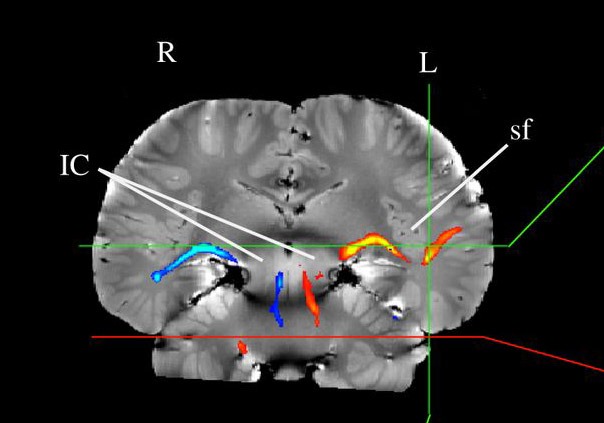New Imaging Technique Reveals Dolphin Brain Pathways

Figure shows the new pathways (in blue and yellow) connecting the midbrain of a dolphin to the temporal lobe.
Two dolphins who died more than a decade ago on a North Carolina beach are now the focus of an unprecedented finding in the scientific literature, giving scientists new information about how dolphin brains process sounds.
The new paper is co-authored by Kimmela Center Executive Director Lori Marino, who joined with colleagues at Emory University and at the University of Oxford to use a new imaging method, called Diffusion Tensor Imaging (DTI), to explore the connections between areas in the two dolphin brains. Each of the large brains had to be scanned for over 12 hours for the imaging data to be obtained.
Earlier studies of a different type, done with live dolphins in Russia, showed that the pathway from the inner ear to the cortex of the brain culminates at the apex of the brain next to the visual processing area. All of that made sense because dolphins are echolocators and integrate visual and acoustic information very quickly.
The unique arrangement of the dolphin brain was added to existing pathways already laid down in mammals.
But when Marino and her colleagues used DTI to examine connections in the postmortem dolphin brains they discovered something never before seen: yet another pathway from the ear to a different part of the brain, the temporal lobe, where the primary auditory cortex of most mammals is located.
This second connection shows that the unique arrangement of the dolphin brain was added to existing pathways already laid down in mammals.
“We found that there are probably multiple areas in the dolphin brain associated with auditory information, and the neural pathways look similar to those of a bat,” lead author Greg Berns says. “This is surprising because dolphins and bats are far apart on the evolutionary tree. They diverged tens of millions of years ago but their brains may have evolved similar mechanisms for using sound not just to hear, but to also create mental images.”
Now that this imaging technique has demonstrated it can reveal connectivity patterns in postmortem cetacean brains, a whole world of opportunity opens up for exploring dolphin and whale brains, and all non-invasively.
